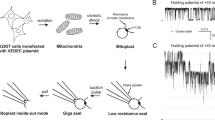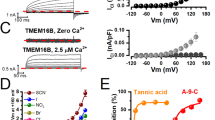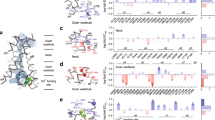Abstract
Cell signalling requires efficient Ca2+ mobilization from intracellular stores through Ca2+ release channels, as well as predicted counter-movement of ions across the sarcoplasmic/endoplasmic reticulum membrane to balance the transient negative potential generated by Ca2+ release1,2,3,4,5,6,7. Ca2+ release channels were cloned more than 15 years ago8,9, whereas the molecular identity of putative counter-ion channels remains unknown. Here we report two TRIC (trimeric intracellular cation) channel subtypes that are differentially expressed on intracellular stores in animal cell types. TRIC subtypes contain three proposed transmembrane segments, and form homo-trimers with a bullet-like structure. Electrophysiological measurements with purified TRIC preparations identify a monovalent cation-selective channel. In TRIC-knockout mice suffering embryonic cardiac failure, mutant cardiac myocytes show severe dysfunction in intracellular Ca2+ handling. The TRIC-deficient skeletal muscle sarcoplasmic reticulum shows reduced K+ permeability, as well as altered Ca2+ ‘spark’ signalling and voltage-induced Ca2+ release. Therefore, TRIC channels are likely to act as counter-ion channels that function in synchronization with Ca2+ release from intracellular stores.
This is a preview of subscription content, access via your institution
Access options
Subscribe to this journal
Receive 51 print issues and online access
$199.00 per year
only $3.90 per issue
Buy this article
- Purchase on Springer Link
- Instant access to full article PDF
Prices may be subject to local taxes which are calculated during checkout




Similar content being viewed by others
References
Ebashi, S. Excitation-contraction coupling. Annu. Rev. Physiol. 38, 293–313 (1976)
Berridge, M. J. The endoplasmic reticulum: a multifunctional signaling organelle. Cell Calcium 32, 235–249 (2002)
Fill, M. & Copello, J. A. Ryanodine receptor calcium release channels. Physiol. Rev. 82, 893–922 (2002)
Somlyo, A. V., Shuman, H. & Somlyo, A. P. Composition of sarcoplasmic reticulum in situ by electron probe X-ray microanalysis. Nature 268, 556–558 (1977)
Coronado, R. & Miller, C. Decamethonium and hexamethonium block K+ channels of sarcoplasmic reticulum. Nature 288, 495–497 (1980)
Fink, R. H. & Veigel, C. Calcium uptake and release modulated by counter-ion conductances in the sarcoplasmic reticulum of skeletal muscle. Acta Physiol. Scand. 156, 387–396 (1996)
Meissner, G. Monovalent ion and calcium ion fluxes in sarcoplasmic reticulum. Mol. Cell. Biochem. 55, 65–82 (1983)
Takeshima, H. et al. Primary structure and expression from complementary DNA of skeletal muscle ryanodine receptor. Nature 339, 439–445 (1989)
Furuichi, T. et al. Primary structure and functional expression of the inositol 1,4,5-trisphosphate-binding protein P400. Nature 342, 32–38 (1989)
Takeshima, H. et al. Mitsugumin29, a novel synaptophysin family member from the triad junction in skeletal muscle. Biochem. J. 331, 317–322 (1998)
Takeshima, H. et al. Junctophilins: a novel family of junctional membrane complex proteins. Mol. Cell 6, 11–22 (2000)
Dani, J. A. & Mayer, M. L. Structure and function of glutamate and nicotinic acetylcholine receptors. Curr. Opin. Neurobiol. 5, 310–317 (1995)
Ogura, T. & Sato, C. Auto-accumulation method using simulated annealing enables fully automatic particle pickup completely free from a matching template or learning data. J. Struct. Biol. 146, 344–358 (2004)
Ogura, T. & Sato, C. Automatic particle pickup method using a neural network has high accuracy by applying an initial weight derived from eigenimages: a new reference free method for single-particle analysis. J. Struct. Biol. 145, 63–75 (2004)
Ogura, T., Iwasaki, K. & Sato, C. Topology representing network enables highly accurate classification of protein images taken by cryo electron-microscope without masking. J. Struct. Biol. 143, 185–200 (2003)
van Heel, M. et al. Single-particle electron cryo-microscopy: towards atomic resolution. Q. Rev. Biophys. 33, 307–369 (2000)
Mio, K. et al. Visualization of the trimeric P2X2 receptor with a crown-capped extracellular domain. Biochem. Biophys. Res. Commun. 337, 998–1005 (2005)
Cowan, S. W. et al. Crystal structures explain functional properties of two E. coli porins. Nature 358, 727–733 (1992)
Liu, Q.-Y. et al. Reconstitution of the solubilized cardiac sarcoplasmic reticulum potassium channel identification of a putative Mr ∼80 kDa polypeptide constituent. FEBS Lett. 291, 13–16 (1991)
Takeshima, H. et al. Embryonic lethality and abnormal cardiac myocytes in mice lacking ryanodine receptor type 2. EMBO J. 17, 3309–3316 (1998)
Endo, M. Calcium release from the sarcoplasmic reticulum. Physiol. Rev. 57, 71–108 (1977)
Meissner, G. Ryanodine receptor/Ca2+ release channels and their regulation by endogenous effectors. Annu. Rev. Physiol. 56, 485–508 (1994)
Fabiato, A. Calcium-induced release of calcium from the cardiac sarcoplasmic reticulum. Am. J. Physiol. 245, C1–C14 (1983)
Antoon, F. M. et al. Presence of functional sarcoplasmic reticulum in the developing heart and its confinement to chamber myocardium. Dev. Biol. 223, 279–290 (2000)
Wang, X. et al. Uncontrolled calcium sparks act as a dystrophic signal for mammalian skeletal muscle. Nature Cell Biol. 7, 525–530 (2005)
Weisleder, N. et al. Muscle aging is associated with compromised Ca2+ spark signaling and segregated intracellular Ca2+ release. J. Cell Biol. 174, 639–645 (2006)
Collet, C. et al. Intracellular calcium signals measured with indo-1 in isolated skeletal muscle fibers from control and mdx mice. J. Physiol. (Lond.) 520, 417–429 (1999)
Toyoshima, C. & Inesi, G. Structural basis of ion pumping by Ca2+-ATPase of the sarcoplasmic reticulum. Annu. Rev. Biochem. 73, 269–292 (2004)
Meissner, G. & Young, R. C. Proton permeability of sarcoplasmic reticulum vesicles. J. Biol. Chem. 255, 6814–6819 (1980)
Kourie, J. I. et al. Characteristics of two types of chloride channel in sarcoplasmic reticulum vesicles from rabbit skeletal muscle. Biophys. J. 70, 202–221 (1996)
Saito, A. et al. Preparation and morphology of sarcoplasmic reticulum terminal cisternae from rabbit skeletal muscle. J. Cell Biol. 99, 875–885 (1984)
Fernandez, J. L., Rosemblatt, M. & Hidalgo, C. Highly purified sarcoplasmic reticulum vesicles are devoid of Ca2+-independent (‘basal’) ATPase activity. Biochim. Biophys. Acta 599, 552–568 (1980)
Zhang, M. et al. Calumin, a novel Ca2+-binding transmembrane protein on the endoplasmic reticulum. Cell Calcium (in the press)
Feramisco, J. D., Goldstein, J. L. & Brown, M. S. Membrane topology of human Insig-1, a protein regulator of lipid synthesis. J. Biol. Chem. 279, 8487–8496 (2004)
Faulk, W. P. & Taylor, G. M. An immunocolloid method for the electron microscope. Immunochemistry 8, 1081–1083 (1971)
Frank, J. Three-dimensional Electron Microscopy of Macromolecular Assemblies (Oxford Univ. Press, New York, 2006)
Harauz, G. & van Heel, M. Exact filters for general geometry three dimensional reconstruction. Optik 73, 146–156 (1986)
Ma, J. Block by ruthenium red of the ryanodine-activated calcium release channel of skeletal muscle. J. Gen. Physiol. 102, 1031–1056 (1993)
Takeshima, H. et al. Excitation-contraction uncoupling and muscular degeneration in mice lacking functional skeletal muscle ryanodine-receptor gene. Nature 369, 556–559 (1994)
Li, E., Bestor, T. H. & Jaenish, R. Targeted mutation of the DNA methyltransferase gene results in embryonic lethality. Cell 69, 915–926 (1992)
Acknowledgements
We thank M. Kameyama for technical assistance, M. Fill and G. Meissner for suggestions, K. Hirose for close cooperation in electron microscopy studies, H. Masumiya for help with the lipid bilayer measurements, and T. Iwamoto for providing anti-NCX1 antibody. This work was supported in part by the Ministry of Education, Culture, Sports, Science and Technology of Japan, the Japan Science and Technology Agency, the Ministry of Health and Welfare of Japan, the Japan New Energy and Industrial Technology Development Organization, the Naito Foundation, the Sumitomo Foundation, the Uehara Memorial Foundation, the Takeda Science Foundation, and the National Institutes of Health.
Author Contributions M.Y., J.F. and M.Z. conducted biochemical experiments and characterized TRIC-DKO mice. K.M., T.O. and C.S. reconstructed the three-dimensional structure. M.Y., Z.P. and J.M. conducted bilayer measurements. C.F., P-H.L., N.W., X.Z. and J.M. characterized TRIC-deficient skeletal muscle. S.K. was responsible for histology. K.K., M.N. and H.T. identified TRIC subtypes and produced knockout mice. H.T. oversaw the project.
Sequence data for rabbit and mouse TRIC channel cDNAs have been deposited in the DDBJ/NCBI/EMBL nucleotide databases under accession numbers of AB261158–AB261160.
Author information
Authors and Affiliations
Corresponding author
Ethics declarations
Competing interests
Reprints and permissions information is available at www.nature.com/reprints. The authors declare no competing financial interests.
Supplementary information
Supplementary Figures
This file includes Supplementary Figures S1-S10 with Legends. (PDF 1671 kb)
Rights and permissions
About this article
Cite this article
Yazawa, M., Ferrante, C., Feng, J. et al. TRIC channels are essential for Ca2+ handling in intracellular stores. Nature 448, 78–82 (2007). https://doi.org/10.1038/nature05928
Received:
Accepted:
Issue Date:
DOI: https://doi.org/10.1038/nature05928
This article is cited by
-
Pathogenic mechanisms of osteogenesis imperfecta, evidence for classification
Orphanet Journal of Rare Diseases (2023)
-
Atypical cell death and insufficient matrix organization in long-bone growth plates from Tric-b-knockout mice
Cell Death & Disease (2023)
-
Identity revealed for a long-sought ER anion channel
Cell Research (2023)
-
Disruption of ER ion homeostasis maintained by an ER anion channel CLCC1 contributes to ALS-like pathologies
Cell Research (2023)
-
Sigma non-opioid receptor 1 is a potential therapeutic target for long QT syndrome
Nature Cardiovascular Research (2022)
Comments
By submitting a comment you agree to abide by our Terms and Community Guidelines. If you find something abusive or that does not comply with our terms or guidelines please flag it as inappropriate.



